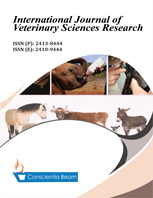Morphometrical Traits and Structural Indices of Malle Cattle Reared in the South Omo Zone of Southwest Ethiopia
DOI:
https://doi.org/10.18488/journal.110.2019.52.32.47Abstract
The aim of this study was to morphometrically and morphologically characterized Malle cattle using some predefined qualitative and quantitative parameters. Data were collected through field observations and linear measurements. Sample data were collected from 360 cattle of different ages and sexes for morphometrical measurements. Qualitative traits were evaluated using non parametric tests. Quantitative traits were analyzed using descriptive statistics. The observed coat color patterns of cattle were predominantly plain. Red and white colored animals predominated across both the sexes. The morphometrical measurements of Bulls with young age group (4 year age) exert strong significant effect (p<0.01) on heart girth (HG), height at rump (HR), height at withers(HW), neck circumference (NC), muzzle circumference (MC) and chest depth(CD) while in cows with age group 4 significant effect (p<0.01) on heart girth (HG) and muzzle circumference (MC) whereas (p<0.05) height at withers (HW) were observed. Similarly, in age group 5 significance effect (p<0.01) on heart girth (HG), neck circumference (NC) and chest width (CW) whereas (p<0.05) height at rump (HR) and height at wither (HW) were also observed. The weight of the bulls and cows were best assessed using skeletal measurements viz. body length, height at withers and rump, besides chest depth and width. The structural indices indicated that the cattle were well balanced and body length and height were more or less proportional. It was conclude that, along with other managerial improvement, the productive aptitude of the cattle through morphometry can provides relevant information to guide and enhance their productive performance.

